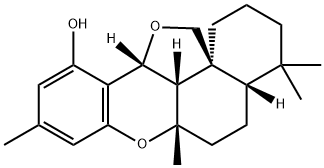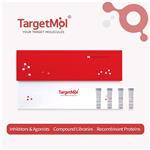Description
Siccanin is an inhibitor of mitochondrial complex II (succinate dehydrogenase; IC
50s = 0.87 and 9.3 μM for
P. aeruginosa and rat mitochondria, respectively). It inhibits the growth of
T. mentagrophytes (IC
50 = 0.3 μg/ml)
via inhibition of succinate oxidation in the mitochondria. It also inhibits the growth of
C. albicans strains with IC
50 values ranging from 5-40 and 80-90 μg/ml for aerobic and anaerobic conditions, respectively.
Uses
Siccanin is an antifungal and SDHB (IP) inhibitor.
Uses
Siccanin is an unusual, fused, phenolic pentacycle first isolated from Helminthosporium siccans and reported in 1962 as a potent antifungal agent. Siccanin inhibits succinate dehydrogenase in the terminal electron transport system. More recent studies note the proximity of the siccanin binding site to the quinone-binding site of the enzyme. Species-selective inhibition by siccanin is unique among succinate dehydrogenase inhibitors and offers a lead for new chemotherapeutics.
Definition
ChEBI: Siccanin is an organic heteropentacyclic compound. It has a role as an antifungal drug and a fungal metabolite.
Origin
Siccanin was found in the culture broth of Helminthosporium siccans by Sankyo Co. in 1962.
Biological Activity
Siccanin shows specific and strong ac tivity against the dermatophytes Trichophyton, Epidermophyton, and Microsporum, but ithas almost no activity against other fungi.


